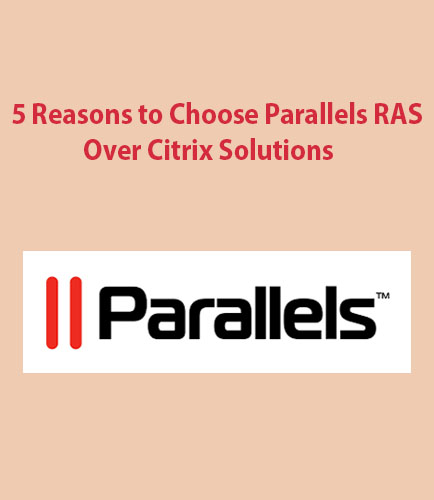
PROCESSING. PLEASE WAIT...

White Paper: Parallels
Virtualization technology is the conspicuous answer for building proficient and financially savvy IT and cloud solutions that enable the majority of employees to get to their information and virtual desktops safely. Citrix®, specifically, has driven the field of virtualization and application and virtual desktop delivery. Business software should be a means to automate and ease business operations rather than a means to introduce new, complex operations and costs. And that is exactly where Parallels has the edge on Citrix: Parallels RAS is a solution that checks all the right boxes.
Parallels Remote Application Server is a cost-effective, all-in-one application and virtual desktop delivery solution that is easy to use and manage. It allows organizations to concentrate their efforts on the line of business rather than on the IT solution to run the business, without breaking the bank account.
Move ahead and read the following whitepaper that will address all your questions, including these:
How Parallels help businesses keep IT infrastructure costs down?
How businesses can build more advanced VDI solutions with less money using Parallels RAS?
Where Citrix falls short?

An endless array of desktop and mobile devices has affected many aspects of everyday life, from personal to corporate workspaces. Particularly, enterprises find themselves caught in a difficult position, as they try to adapt to employee expectations in the mobile-enabled era, where everyone has a preferred platform. Businesses are presented with an expensive challenge to deliver business-related applications on the wide selection of devices and platforms that employees are using to connect to the network. Delivering Windows applications in a way that presents a useful and enjoyable experience for employees—regardless of the device or platform they’re using—often presents a challenge for IT departments within medium and large businesses.
By: Parallels
Virtual Desktop Infrastructure (VDI) can help many large-scale businesses and organizations save money, simplify client image management, improve data security, and enable remote connectivity from any device. Considering the initial capital expense and overall complexity involved with implementing a traditional VDI solution, it’s no wonder that many cost-conscious customers, particularly small and medium businesses, have failed to adopt this traditional approach. In order to facilitate rapid and successful deployment of the Parallels Remote Application Server FlexCast models, the Parallels team has built and tested a solution using the components described in this white paper. Key takeaways from this white paper: Parallels Remote Application Server Virtual Desktop Types Parallels Remote Application Solution Overview Setting up the HVD solution based on the suggested scale-out increment Key decisions points and options offered by Parallels and Nutanix How Parallels Remote Application Server (RAS) reduce the cost and complexity of VDI
By: Parallels
This whitepaper depicts the upsides of utilizing thin clients instead of PCs, furthermore, shows how thin clients can deliver noteworthy cost savings over time to your enterprise. IGEL Technology and Parallels have been working together on thin client computing and virtual desktops since 2002 to deliver a solution for fast and economical implementation of server-based computing and desktop virtualization. This White Paper on “Thin Client” describes: What exactly are Thin Clients? Why Should You Switch to Thin Clients? IGEL Technology: Hardware and Software IGEL Technology: Advantages of Thin Clients IGEL Technology and Parallels Remote Application Server Advantages


 2025 All Rights Reserved | by: www.ciowhitepapersreview.com
2025 All Rights Reserved | by: www.ciowhitepapersreview.com